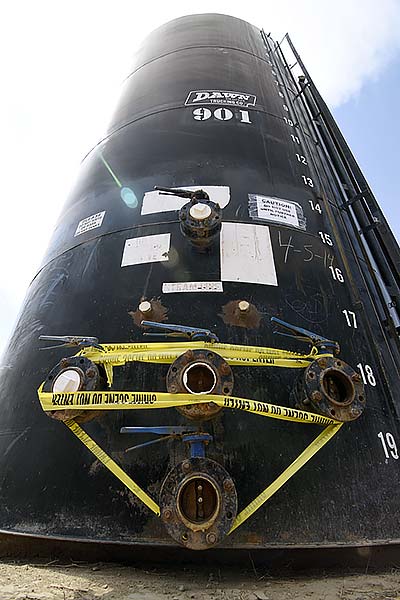
Begaye to decide on opening canals

Yellow caution tape instructs emergency personnel to not touch them Thursday in Shiprock, N.M. Two large tanks were brought in by the U.S. EPA in an effort to increase production in providing water to stricken farmers and ranchers who've been left without a means to water their livestock and crops. It was later discovered the tanks were fracking tanks, which hold dangerous mining chemicals. (Times photo - Donovan Quintero)

Paul Long Jr with the Navajo Nation Department of Water Resources tops of a 55-gallon barrel with non-potable water Thursday in Shiprock, N.M. Residents living along the San Juan River who’ve been affected by the Aug. 5 toxic water spill don’t have access to the river since the Navajo tribal government shut down access to it until further notice. (Times photo – Donovan Quintero)
SHIPROCK

Navajo Nation President Russell Begaye, left, types into his laptop what is said at an open forum on the river contamination at the Phik Thomas Performing Arts Center Thursday night in Shiprock, N.M. (Times photo – Donovan Quintero)
President Russell Begaye Friday morning was tracing the route of the Aug. 5 Gold King Mine waste spill with members of the Navajo Nation Council and a medicine man, blessing the rivers and trying to decide whether to open the San Juan River to irrigation.
An emotional seven-and-one-half-hour meeting with farmers in Shiprock Thursday night had provided little guidance. While most of the 35 or so people who spoke begged him to keep the river closed, a subsequent anonymous paper ballot favored opening it.
The canal system, however, is being flushed Friday — an eight-hour process that cleans the silt out in case Begaye decides to open the system.
The U.S. EPA, which has maintained the river is back to pre-spill levels of heavy metals, has announced it will stop delivering replacement water to Navajo farmers Friday, but Begaye said the tribe and the BIA will continue to try to supply water to all who need it until the canals are open.
The Navajo Nation EPA also announced Thursday their independent test results indicated the river is safe for irrigation — though not yet approved for livestock watering. But the vast majority of the farmers who spoke were unconvinced.
“I don’t want my children to get sterile!” cried one woman.
“Nobody wants to buy our corn!” said another farmer.
 “What’s going to happen when people start dying?” asked someone else.
“What’s going to happen when people start dying?” asked someone else.
Others questioned why the NNEPA wasn’t releasing its test results, other than a vague graph that indicated a spike in contaminants while the plume flowed through and then a steep drop to normal levels over the next few days.
NNEPA Executive Director Donald Benn said the tribe was keeping the results secret because they might be used as evidence in the tribe’s planned lawsuit against the USEPA. He said some of the results were very similar to the USEPA’s but others were different.
Steve Austin of the Navajo Nation Water Quality Program’s Shiprock office showed a graph indicating that even as the toxic plume flowed through the Navajo Nation on Aug. 8, there were no heavy metals that exceeded the Navajo Nation’s standards for irrigation water. However, on Aug. 9, a storm around Aneth apparently stirred up some of the contaminants that had settled to the bottom of the river and, downstream from Shiprock, levels of aluminum and vanadium rose to levels slightly higher than the standards.
“They exceeded briefly and went away,” Austin said, noting that the vanadium level went up by only 10 parts per billion.
But no amount of science seemed to convince the crowd of about 150 farmers that their water was safe, and in spite of Begaye’s repeated iteration that the tribe would sue the USEPA for enough money to build alternative projects, some were still suspicious that the tribe and the federal government were somehow in cahoots.

Yellow caution tape instructs emergency personnel to not touch them Thursday in Shiprock, N.M. Two large tanks were brought in by the U.S. EPA in an effort to increase production in providing water to stricken farmers and ranchers who’ve been left without a means to water their livestock and crops. It was later discovered the tanks were fracking tanks, which hold dangerous mining chemicals. (Times photo – Donovan Quintero)
“The way it sounds, the Navajo Nation is being bought by the EPA,” said J.C. Begay, a farmer who says he has already lost two animals to dehydration. “They need to do a lot more homework before they turn on that water.”

Farmer Barbara Morgan from Shiprock waits her turn to address Navajo Nation President Russell Begaye and key staff members involved in the San Juan River contamination Thursday night in Shiprock, N.M. (Times photo – Donovan Quintero)
To read the full article, pick up your copy of the Navajo Times at your nearest newsstand Thursday mornings!
Are you a digital subscriber? Read the most recent three weeks of stories by logging in to your online account.








 Highway 264,
Highway 264, I-40, WB @ Winslow
I-40, WB @ Winslow